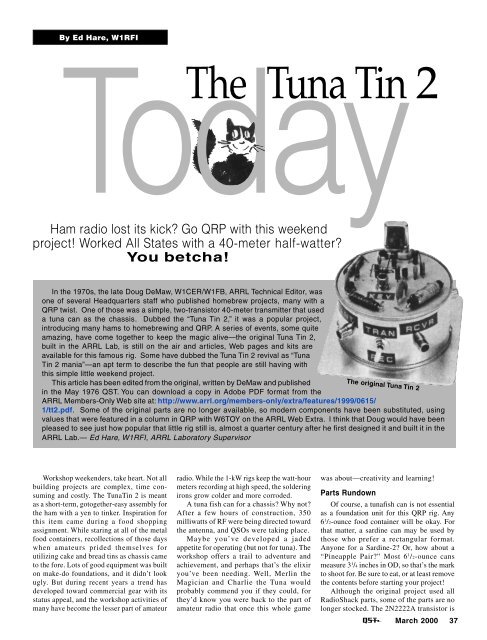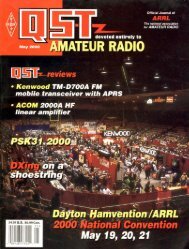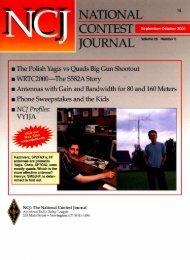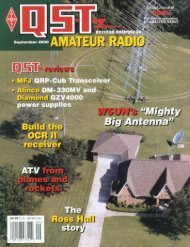An insideview of theQRSerprototype.The large IC atthe bottom(partially hiddenby the frontpanel) is U2.The back side of the front panel. Most of the panel is occupiedby the oval speaker. A strip of perfboard (right) holds the fourLEDs. Across the bottom are the three pots and toggle switch.The RECORD and PLAY pushbuttons are to the left.1807). The speaker and controls occupy mostof the space. This enclosure provides enoughroom for a 3×5-inch oval speaker firing throughthe front panel. Because the playback frequencyis reduced by the same ratio as the CWspeed, it’s best to use a fairly large speaker andenclosure. A 2-inch speaker I tried first did avery poor job of reproducing the 300-Hz outputtone resulting from the halved 600-Hz CWtone I normally use.Good things come in small packages, butbe careful about trying to stuff the QRSerinto a small enclosure. The reed relay is verysensitive to magnetic fields. If it is too closeto the speaker magnet, the relay may be heldclosed even when the coil isn’t energized. Ifyour project works perfectly until you put itinto the box, this is one place to look! AlthoughI’ve not experienced any problemswith prototypes without D2, adding the diodeacross the relay coil to dampen the inductivekick when the relay is deenergizedis a good idea. You’ll have to place D2 onthe foil side of the PC board.Another way to package the QRSer isto build it into an existing speaker enclosureand use a relay actuated by S3 toswitch the speaker between audio fromthe rig and the output of the LM386. Thismakes it unnecessary to turn down the receivervolume in order to hear the recording.Both sides of the speaker shouldbe switched using a DPDT relay toavoid grounding problems. Be sure toinstall a diode across the coil of the addedrelay.The only adjustment required before puttingthe QRSer into operation is to set R1 sothat the frequency of U3F matches that ofthe internal clock in U2. If a frequency meteris available, measure the frequency atpin 10 of U3 and adjust R1 to set it at about820 kHz. Otherwise, your “piano-tuning36 <strong>March</strong> <strong>2000</strong>skills” will come in handy for this procedure.Supply a constant audible signal to theaudio input. Hold S2 closed momentarilythen release it. Press S3 and keep it presseduntil the recorded message ends. Unless yougot lucky and the frequency match is perfect,the reproduced sound will be steadyuntil the end of the recorded tone, then willshift up or down. Moving R1 one way movesthe shift higher in frequency; moving it theother way shifts it lower in frequency. Repeatthe RECORD/PLAY cycle adjusting R1each time until the frequency shift at the endof playback disappears.OperationUsing the QRSer is easy. Connect a suitablesignal source to the audio input andapply power. I use twisted-pair pigtails thatpass through a grommet-protected hole in therear of the enclosure, but you may prefer toinstall jacks and use cables. If the audio-inputsource is unbalanced, the high side must beconnected to C1 and the grounded side to C2.Unless the signal source is of very low amplitude,it should be possible to adjust the INPUTLEVEL control so that DS2 lights to the ditsand dahs of incoming CW. DS3 should notlight except, perhaps, on noise peaks. If an oscilloscopeis available, use it to check the signallevel at pin 20 of U2. The peak-to-peaksignal amplitude should not exceed 50 mV.Press the RECORD pushbutton to recordup to 10 seconds of audio. Press PLAY andadjust the PLAYBACK SPEED. The recordedmessage can be replayed as many times asdesired by releasing the PLAY switch andpressing it again; the message will always startat the beginning of the 10-second interval.AcknowledgementsI want to express my thanks to my dad,W1BSO, for getting me involved withAmateur Radio more years ago than I liketo remember.Notes1Information Storage Devices, 2727 North FirstSt, San Jose, CA 95134; tel 800-677-0769,fax 408-544-1789; http://www.isd.com/.2This input has a maximum signal-input level of20 mV peak to peak and its gain is controlledby a fast-attack/slow-decay AGC. However, Ifound that recordings were noticeably noisierwhen the input level was reduced much belowits maximum value. Because I planned totake audio input from across an 8-Ω speaker,it would be necessary to attenuate the signalconsiderably to bring it below 20 mV. Thereisn’t much sense in attenuating a signal justto amplify it again. The FAR PC board bringspreamp pins 16-18 to pads for the builder whowishes to modify the present design toaccomodulate very low level audio inputs.3PC boards for this project are available fromFAR Circuits, 18N640 Field Ct, Dundee, IL60118-9269; tel 847-836-9148 (voice andfax). Price: $7.50 plus $1.50 shipping for upto four boards. Visa and MasterCard acceptedwith a $3 service charge.4A semi-kit consisting of all semiconductors,sockets for U2-U5, K1, and a PC board is$23 postpaid; $15.50 postpaid without thePC board (see Note 3). Contact CharlieCheney, K1LDZ, 319 Highland St,Northbridge, MA 01534; charliec@ieee.org. Price: $27.50Charlie Cheney, K1LDZ, was first licensed asKN1LDZ in 1959. He’s held an Extra class licensesince 1992. He’s interested in restoringand operating vintage (tube type) ham gear,and in building homebrew equipment. ForDXing and contests, however, he’s “not averseto using more modern equipment.” His favoritemode is CW (including mobile). Charlieholds a BS from Boston College and an MSfrom the University of Chicago. He works asthe principal software engineer for QuadTechInc (formerly GenRad Instruments) writingfirmware for electronic test equipment. You cancontact Charlie at 319 Highland St,Northbridge, MA 01534; charliec@ieee.org.
TodayThe Tuna Tin 2By Ed Hare, W1RFIHam radio lost its kick? Go QRP with this weekendproject! Worked All States with a 40-meter half-watter?You betcha!In the 1970s, the late Doug DeMaw, W1CER/W1FB, ARRL Technical Editor, wasone of several Headquarters staff who published homebrew projects, many with aQRP twist. One of those was a simple, two-transistor 40-meter transmitter that useda tuna can as the chassis. Dubbed the “Tuna Tin 2,” it was a popular project,introducing many hams to homebrewing and QRP. A series of events, some quiteamazing, have come together to keep the magic alive—the original Tuna Tin 2,built in the ARRL Lab, is still on the air and articles, Web pages and kits areavailable for this famous rig. Some have dubbed the Tuna Tin 2 revival as “TunaTin 2 mania”—an apt term to describe the fun that people are still having withthis simple little weekend project.This article has been edited from the original, written by DeMaw and publishedin the May 1976 <strong>QST</strong>. You can download a copy in Adobe PDF format from theARRL Members-Only Web site at: http://www.arrl.org/members-only/extra/features/1999/0615/1/tt2.pdf. Some of the original parts are no longer available, so modern components have been substituted, usingvalues that were featured in a column in QRP with W6TOY on the ARRL Web Extra. I think that Doug would have beenpleased to see just how popular that little rig still is, almost a quarter century after he first designed it and built it in theARRL Lab.— Ed Hare, W1RFI, ARRL Laboratory SupervisorThe original Tuna Tin 2Workshop weekenders, take heart. Not allbuilding projects are complex, time consumingand costly. The TunaTin 2 is meantas a short-term, gotogether-easy assembly forthe ham with a yen to tinker. Inspiration forthis item came during a food shoppingassignment. While staring at all of the metalfood containers, recollections of those dayswhen amateurs prided themselves forutilizing cake and bread tins as chassis cameto the fore. Lots of good equipment was builton make-do foundations, and it didn’t lookugly. But during recent years a trend hasdeveloped toward commercial gear with itsstatus appeal, and the workshop activities ofmany have become the lesser part of amateurradio. While the 1-kW rigs keep the watt-hourmeters recording at high speed, the solderingirons grow colder and more corroded.A tuna fish can for a chassis? Why not?After a few hours of construction, 350milliwatts of RF were being directed towardthe antenna, and QSOs were taking place.Maybe you’ve developed a jadedappetite for operating (but not for tuna). Theworkshop offers a trail to adventure andachievement, and perhaps that’s the elixiryou’ve been needing. Well, Merlin theMagician and Charlie the Tuna wouldprobably commend you if they could, forthey’d know you were back to the part ofamateur radio that once this whole gamewas about—creativity and learning!Parts RundownOf course, a tunafish can is not essentialas a foundation unit for this QRP rig. Any6 1 /2-ounce food container will be okay. Forthat matter, a sardine can may be used bythose who prefer a rectangular format.Anyone for a Sardine-2? Or, how about a“Pineapple Pair?” Most 6 1 /2-ounce cansmeasure 3 1 /4 inches in OD, so that’s the markto shoot for. Be sure to eat, or at least removethe contents before starting your project!Although the original project used allRadioShack parts, some of the parts are nolonger stocked. The 2N2222A transistor is<strong>March</strong> <strong>2000</strong> 37
- Page 6 and 7: March 2000 Volume 84 Number 3David
- Page 11 and 12: THE AMERICAN RADIORELAY LEAGUE INC
- Page 14: Get to Know Your Section ManagerThe
- Page 18: Senate CommerceChairman andPresiden
- Page 22 and 23: GEORGE DOMINICK, W4UWCLooking for a
- Page 26 and 27: CORRESPONDENCEYour opinions count!
- Page 30 and 31: By Stephen Stuntz, N0BFImagine ridi
- Page 32 and 33: By David A. Rosenthal, N6TSTDXing W
- Page 34 and 35: It was a ham’s dream, sitting onM
- Page 36 and 37: always start at the beginning of me
- Page 40 and 41: Kits and BoardsWhile the original T
- Page 42 and 43: TT2 PerformanceKeying quality with
- Page 44 and 45: Figure 1—Schematic of the meter-m
- Page 46 and 47: Figure 1—Schematic of the Simple
- Page 48 and 49: tacts I had while using this transm
- Page 50 and 51: chandisers are free to develop “s
- Page 52 and 53: WORKBENCHPROJECTS AND INFORMATION F
- Page 54 and 55: THE HELP DESKSchematic Symbols52 Ma
- Page 56 and 57: paddle. This can be done with eithe
- Page 58 and 59: creator) was providing free PSK31 s
- Page 60 and 61: By H. Ward Silver, N0AXTest Your Kn
- Page 62 and 63: HINTS & KINKSA SIMPLE ANTENNA FLIPP
- Page 64 and 65: By Dave Patton, NT1N2000 Annual Mee
- Page 66 and 67: The Board welcomed three new Vice D
- Page 68 and 69: Craigie nominated Mr. Butler. Mr. B
- Page 70 and 71: D.C., with the specific responsibil
- Page 72 and 73: Table 1Elecraft K2, serial number 0
- Page 74 and 75: two inductors. Don’t let this hap
- Page 76 and 77: Like most transceivers these days,
- Page 78 and 79: Table 2Alinco DJ-V5TH, serial numbe
- Page 80 and 81: FCC NewsENHANCED AMATEUR ENFORCEMEN
- Page 82 and 83: tem is not legal to use as it’s c
- Page 84 and 85: chance to do it. It may be several
- Page 86 and 87: officials and the hundreds of train
- Page 88 and 89:
THE WORLD ABOVE 50 MHZDr. Ernest K.
- Page 90 and 91:
EME AnnalsEME (moonbounce) standing
- Page 92 and 93:
DIGITAL DIMENSIONWinLink 2000: A Wo
- Page 94 and 95:
From the Mailbag…Throughout the y
- Page 96 and 97:
AT THE FOUNDATIONSpringing with New
- Page 98 and 99:
(156.7 Hz), 146.52. Adm: $2. Tables
- Page 100 and 101:
It is with deep regret that we reco
- Page 102 and 103:
CONTEST CORRALFeedbackIn the 1999 A
- Page 104 and 105:
By Dan Henderson, N1NDContest Branc
- Page 106 and 107:
Affiliated Club Competition Results
- Page 108 and 109:
1999 IARU HF WorldChampionship Resu
- Page 110 and 111:
N5XU (+KA5WSS,KM5FA,N3TNN)390,104 8
- Page 112 and 113:
RW4AA 1,299,804 2121 172 ARW3GU 879
- Page 114 and 115:
Revised 1999 June VHF QSO Party Rov
- Page 122:
has been around for some time, is a
- Page 126:
154, WB5ZED 232. Tfc: K5WOD 4, NOKW
- Page 130:
Bethpage, NY. Bob Wexelbaum, W2ILP,
- Page 134:
NEW HAMPSHIRE: SM, Mike Graham, K7C
- Page 138:
136longtime member N6DOC. Installat
- Page 142:
tion of the digital network within
- Page 146:
DEC, EC, ASM, and cabinet member at
- Page 150:
148agencies have had a working rela
- Page 156:
CALL SIGN NAME BADGES. Club logos o
- Page 160:
COMPUTERS - WANTED early Pre-1980 m
- Page 176:
Index of AdvertisersADVERTISING DEP
















